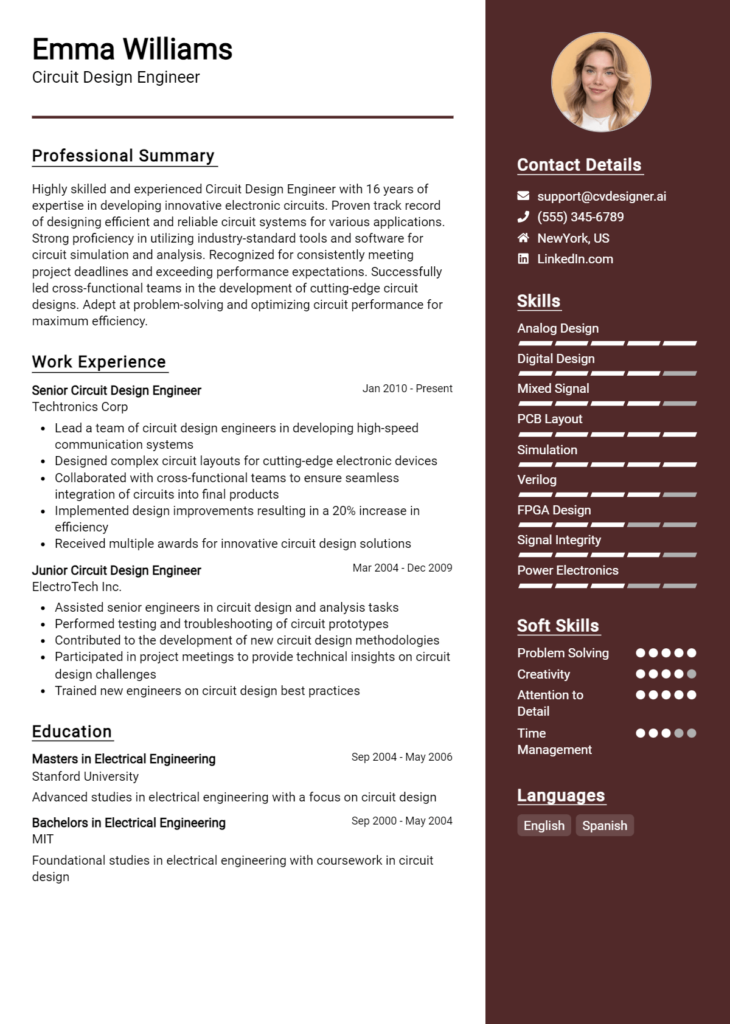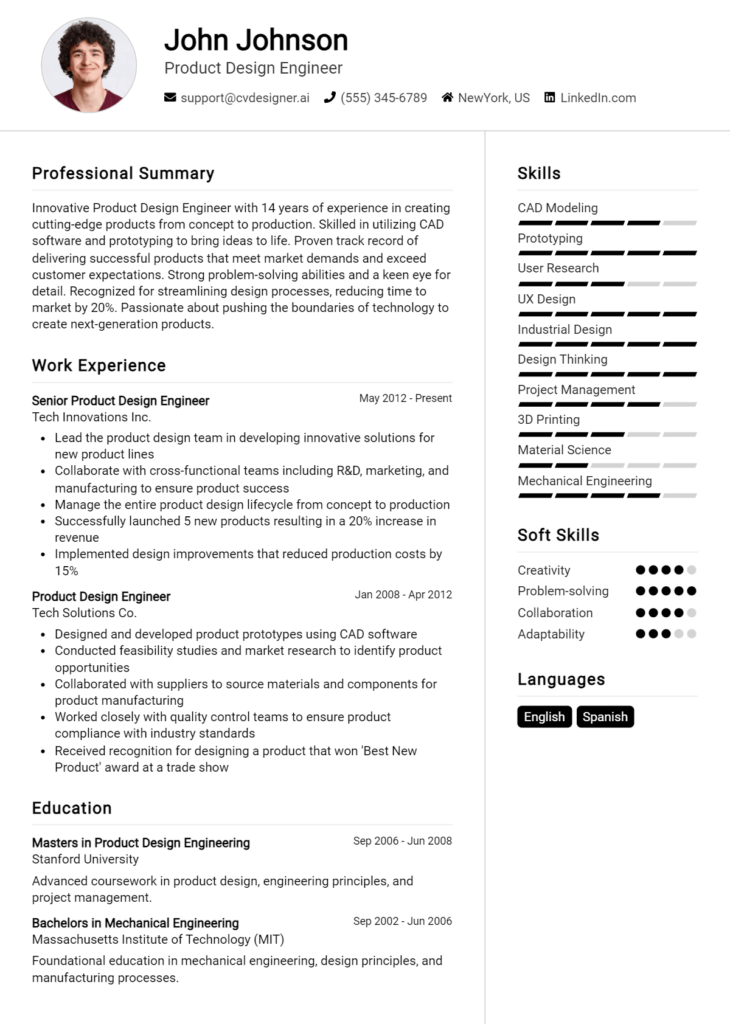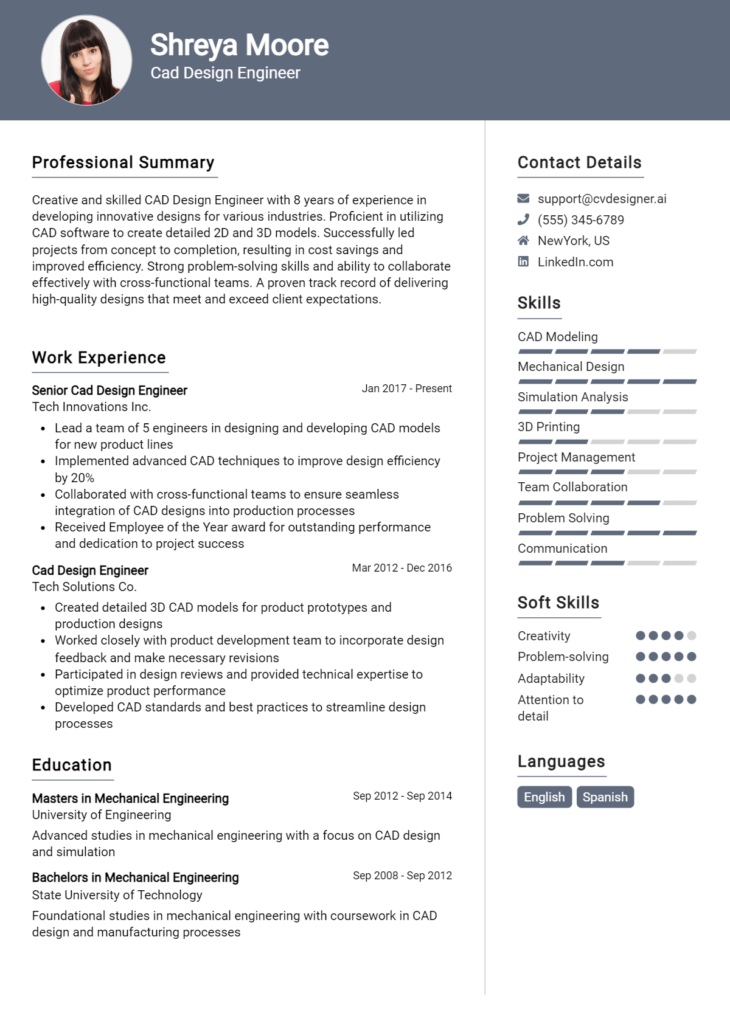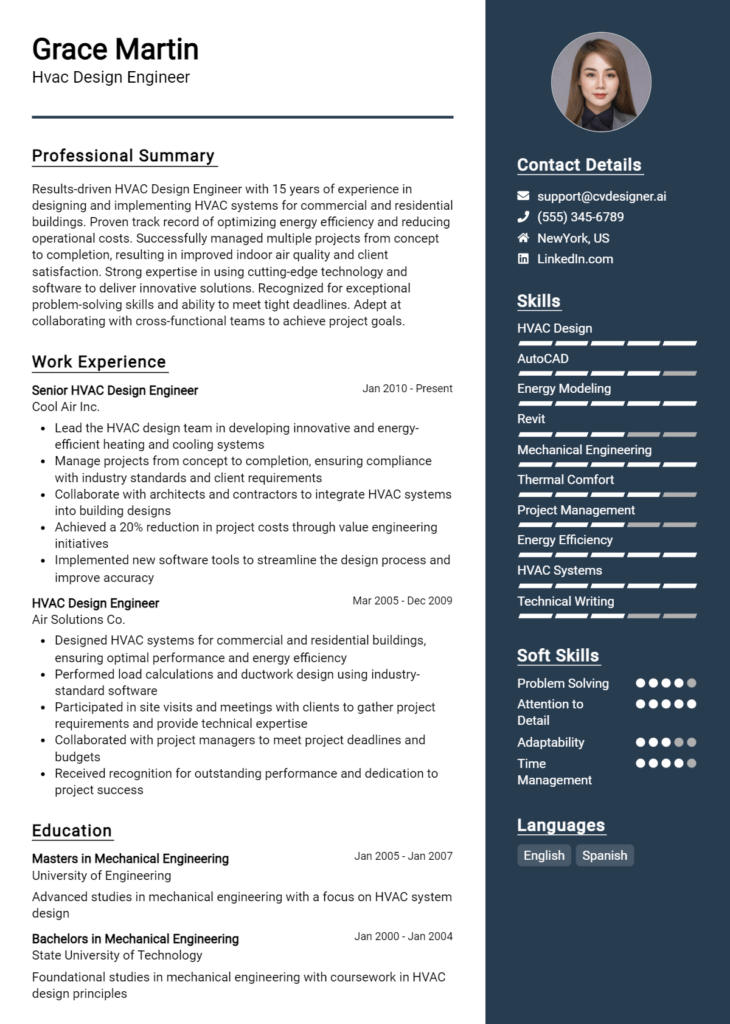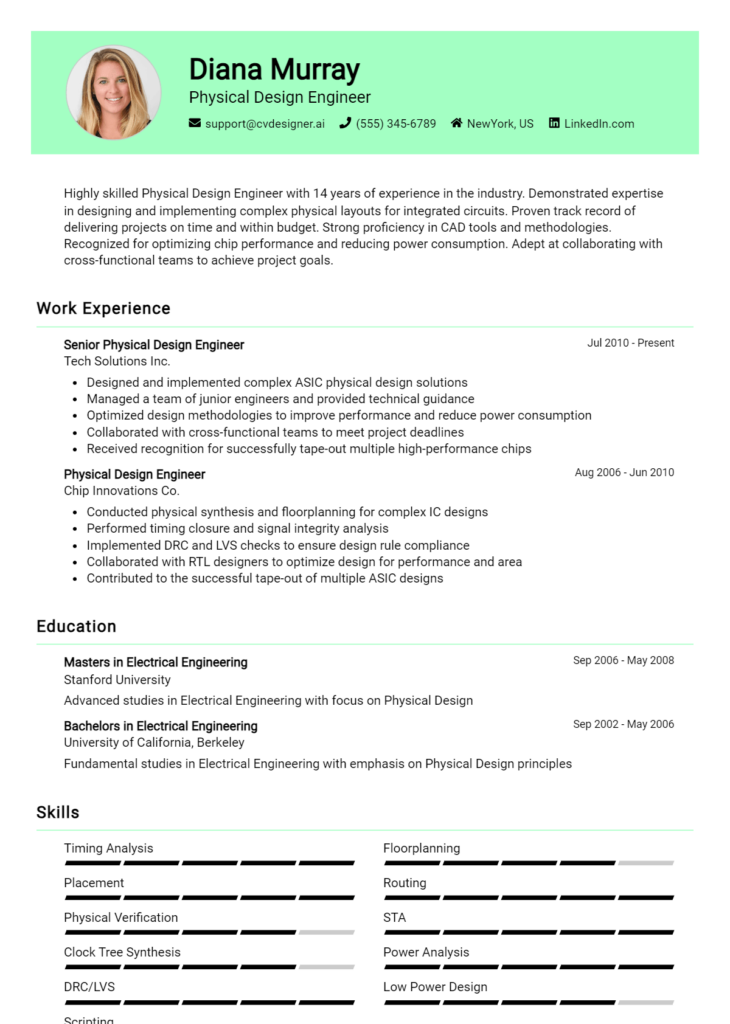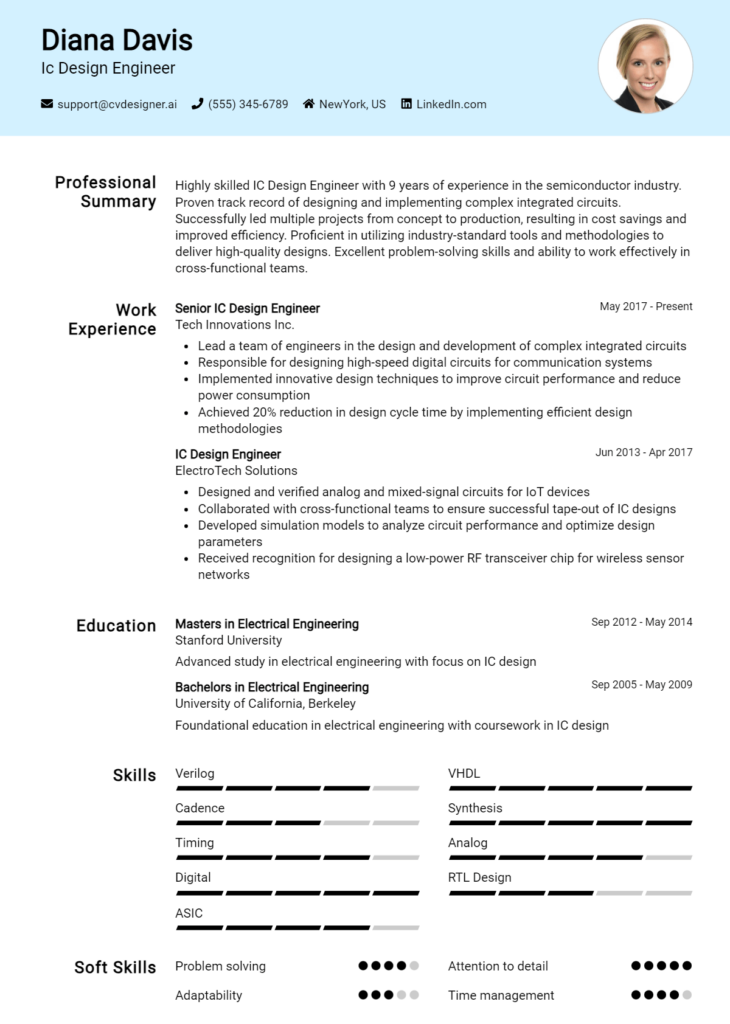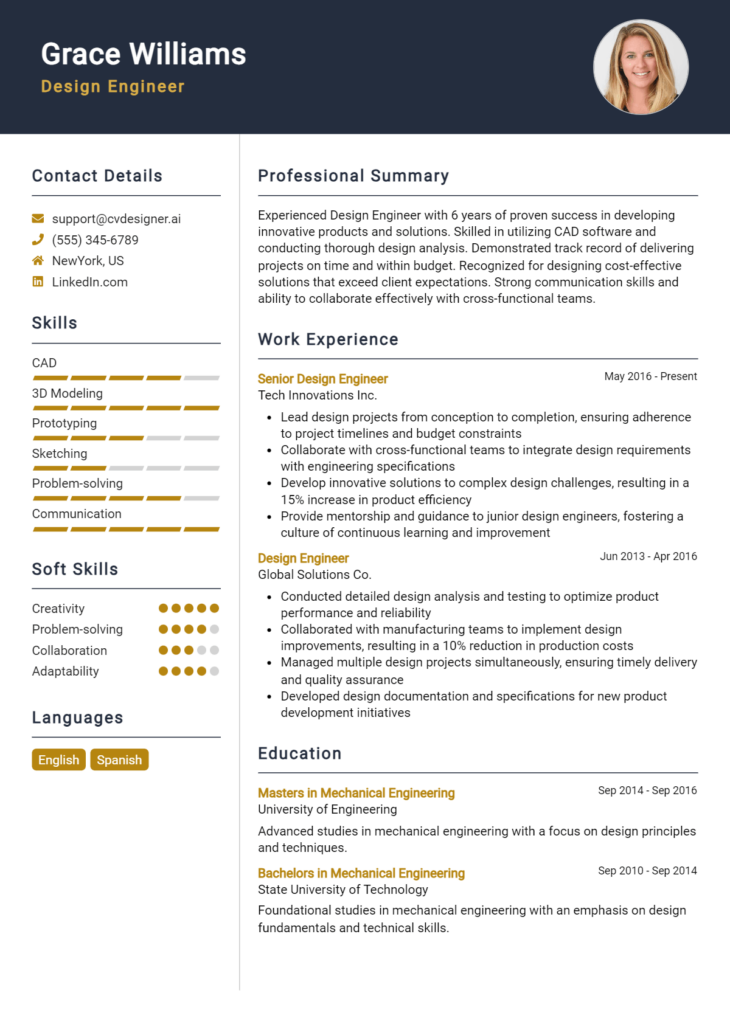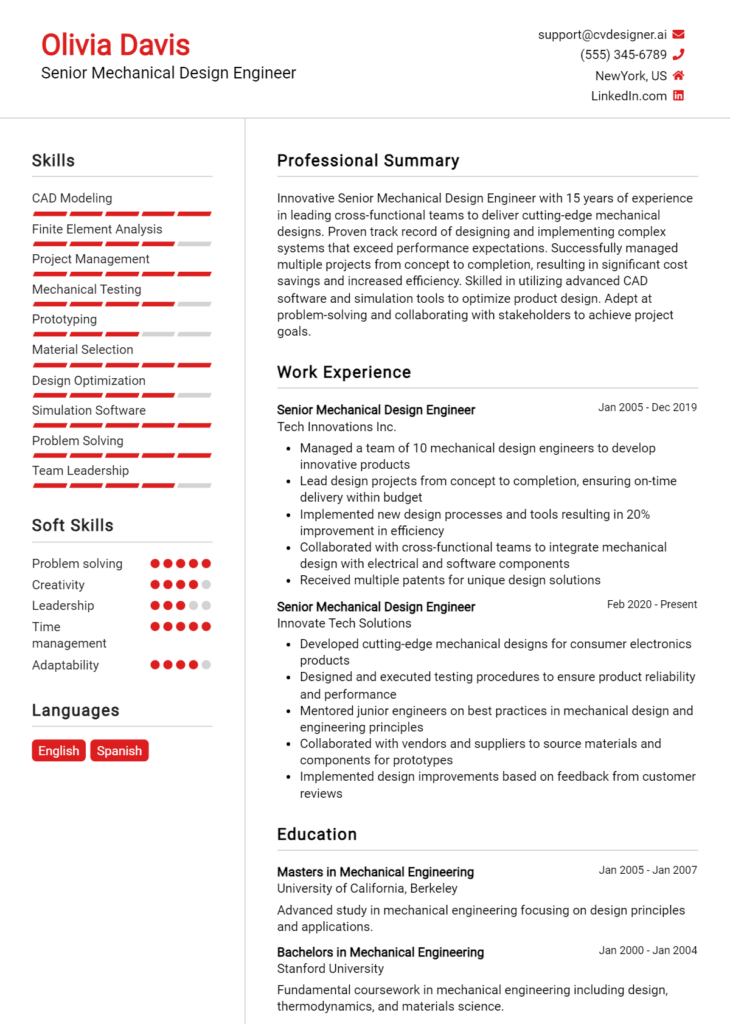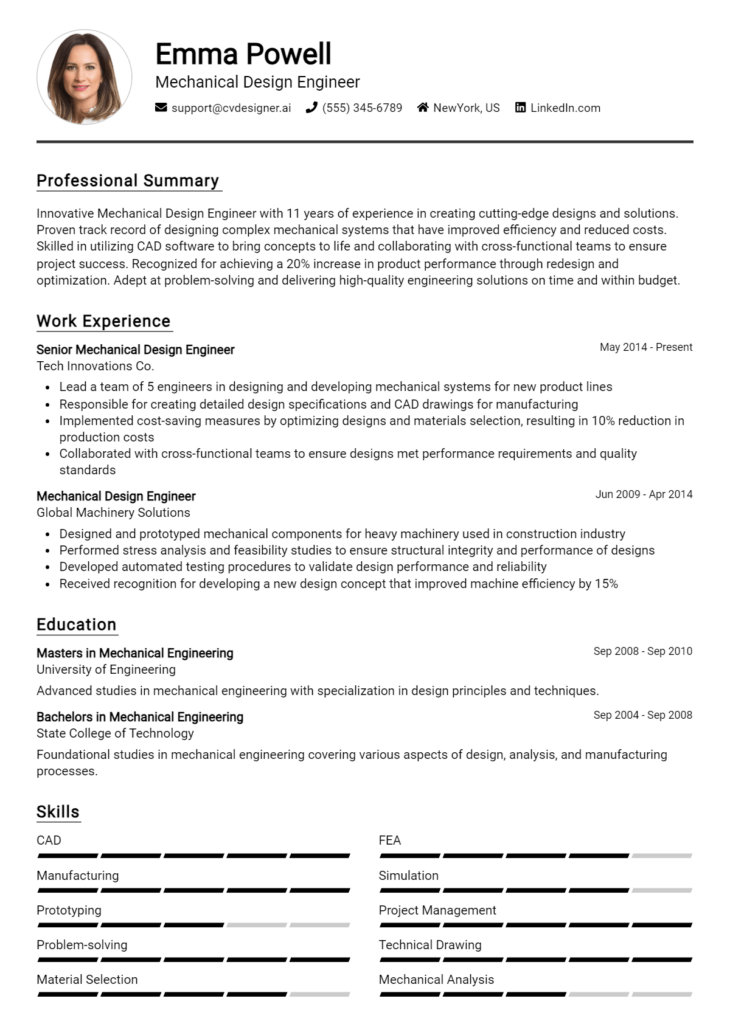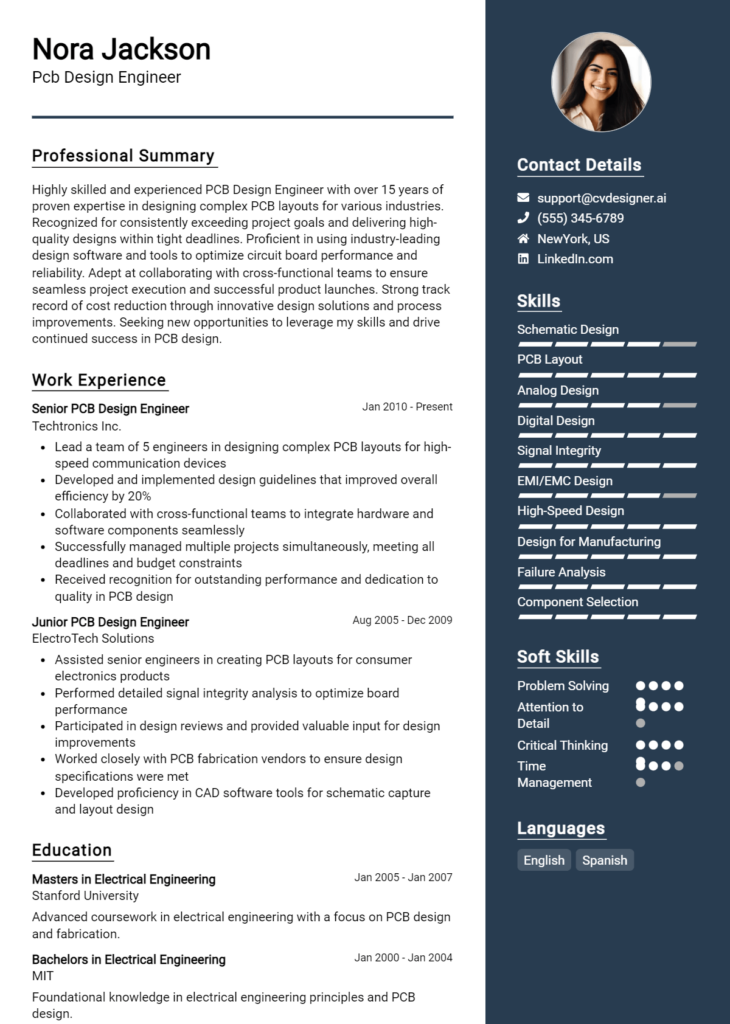Most Popular Hardware Design Engineer Resume Examples
Explore additional Hardware Design Engineer resume samples and guides and see what works for your level of experience or role.
As a Hardware Design Engineer, you play a pivotal role in the development of cutting-edge technology that powers our modern world. From designing intricate circuit boards to integrating complex systems, your expertise is at the core of innovation in industries ranging from consumer electronics to aerospace. However, to land your dream job in this competitive field, a well-crafted resume is essential. It not only showcases your technical skills and experiences but also conveys your passion and commitment to the craft. Crafting an impressive resume can set you apart from the competition and open doors to exciting opportunities.
In this comprehensive guide, we will explore the crucial elements of a standout Hardware Design Engineer resume. You will learn about the core responsibilities and key skills that hiring managers look for, as well as the best formats to present your qualifications effectively. We will highlight common pitfalls to avoid that can diminish your chances of making a lasting impression. Additionally, you will find resume examples tailored for various experience levels, from entry-level positions to seasoned professionals. To enhance your resume writing journey, we’ll provide practical tips on how to create a compelling narrative and select the right resume templates to showcase your unique strengths. Whether you are just starting out or looking to advance your career, this guide will equip you with the knowledge and tools needed to create a resume that truly stands out.
Key Responsibilities and Skills for a Hardware Design Engineer
As a Hardware Design Engineer, you play a pivotal role in developing and optimizing hardware components for various applications. Your primary responsibilities include designing, testing, and implementing hardware systems while collaborating closely with cross-functional teams to ensure product specifications are met. You are also tasked with troubleshooting hardware issues and continuously improving design processes to enhance performance and reliability.
Key Responsibilities:
- Develop and design hardware components, circuits, and systems based on project requirements.
- Conduct simulations and tests to validate design functionality and performance.
- Collaborate with software engineers to ensure hardware-software integration.
- Prepare technical documentation, including specifications and reports.
- Manage project timelines and deliverables to meet deadlines.
- Troubleshoot and resolve hardware-related issues during prototyping and production phases.
- Stay updated with industry trends and emerging technologies to incorporate into designs.
Essential Skills:
- Proficiency in circuit design and analysis tools (e.g., Altium, Cadence).
- Strong knowledge of digital and analog electronics.
- Experience with PCB layout and design.
- Familiarity with hardware description languages (HDLs) like VHDL or Verilog.
- Excellent problem-solving and analytical skills.
- Strong communication and teamwork abilities.
- Attention to detail and a thorough understanding of design specifications.
Highlighting these skills effectively in the resume skills section is crucial. Tailoring your listed responsibilities and skills to match the job description not only showcases your qualifications but also demonstrates your attention to detail and alignment with the prospective employer's needs. This strategy can significantly enhance your chances of being noticed by hiring managers.
Additionally, consider how these skills can be articulated in your CV to create a strong narrative about your qualifications. Emphasizing relevant experiences and accomplishments in relation to these skills can make your application more compelling and increase your chances of securing an interview.
Best Resume Format and Structure for a Hardware Design Engineer
When crafting a resume for a Hardware Design Engineer position, it's crucial to choose a format that highlights your technical skills, relevant experience, and educational background effectively. Here’s a detailed guide on the best resume format and structure for a Hardware Design Engineer.
Contact Information
- At the top of your resume, include your full name, phone number, email address, and LinkedIn profile (if applicable). Make sure this information is clear and easy to read.
Professional Summary
- Write a concise summary that captures your career trajectory, highlighting your years of experience, key skills, and areas of expertise. Tailor this section to align with the specific job you are applying for by including relevant keywords from the job description. Aim for 3-4 sentences that demonstrate your value as a Hardware Design Engineer.
Work Experience
- List your work experience in reverse chronological order, starting with your most recent position. For each role, include:
- Job Title
- Company Name
- Location (City, State)
- Dates of Employment (Month/Year - Month/Year)
- Bullet points detailing your responsibilities and achievements. Focus on quantifiable results and specific contributions to projects. Use action verbs to convey your impact, such as “designed,” “developed,” “implemented,” or “led.”
Education
- Include your educational background, starting with the most recent degree. For each entry, provide:
- Degree (e.g., Bachelor of Science in Electrical Engineering)
- Institution Name
- Location (City, State)
- Graduation Date (Month/Year)
- If you have relevant coursework or projects, consider adding a brief list that showcases your technical expertise.
Skills
- Create a dedicated section to highlight both hard and soft skills relevant to hardware design engineering. This could include:
- Technical skills: CAD software (e.g., Altium, AutoCAD), PCB design, FPGA programming, circuit analysis, etc.
- Soft skills: Problem-solving, teamwork, communication, and project management.
Certifications
- If you have obtained any relevant certifications (e.g., Certified Electronics Technician, IPC Certification), list them in a separate section. Include:
- Certification Name
- Issuing Organization
- Date Obtained
Tips for Choosing the Right Format
- Opt for a clean and professional layout that enhances readability. A chronological or combination format is often the best choice for hardware design engineers, as it showcases both your work history and skills effectively.
- Use clear headings and bullet points to break up text and make your resume scannable.
- Choose a font that is easy to read, and keep the font size between 10-12 points.
- Limit your resume to one or two pages, depending on your experience level.
Complementing Your Cover Letter
- The resume format you select should complement your cover letter format. Use similar fonts, colors, and styles to create a cohesive look. This helps to establish a professional brand.
- In your cover letter, elaborate on specific experiences or projects mentioned in your resume, providing context and demonstrating your passion for the field of hardware design engineering.
In summary, a well-structured resume that highlights your relevant experience, skills, and education will significantly enhance your chances of landing an interview for a Hardware Design Engineer position. Tailor your resume to each job application, ensuring it aligns with the requirements and expectations outlined in the job description.
Writing Tips and Best Practices for a Hardware Design Engineer Resume
When crafting a resume as a Hardware Design Engineer, it’s essential to highlight both your technical skills and project achievements in a clear and concise manner. A well-structured resume not only showcases your qualifications but also demonstrates your ability to communicate effectively—an important skill in engineering projects. Utilize resume writing tips to ensure your document has a professional appearance. Additionally, keep in mind how these practices can enhance your cover letter, making it more compelling to potential employers.
- Use strong action verbs like "designed," "developed," "implemented," and "optimized" to convey your achievements vividly.
- Quantify your accomplishments where possible (e.g., "reduced power consumption by 30% in the latest circuit design").
- Incorporate industry-specific keywords and phrases that align with job descriptions to pass Applicant Tracking Systems (ATS).
- Organize your resume into clear sections, including a summary, skills, experience, and education, for easy navigation.
- Tailor your resume for each job application to reflect the skills and experiences most relevant to the position.
- Highlight teamwork and collaboration experiences, as hardware design often requires working with cross-functional teams.
- Include certifications or specialized training that enhance your qualifications in hardware design.
- Keep your resume to one page if you have less than 10 years of experience; two pages is acceptable for more extensive careers.
Common Mistakes to Avoid in a Hardware Design Engineer Resume
When crafting a resume as a Hardware Design Engineer, it's crucial to present your skills and experiences in a clear, concise, and engaging manner. However, many candidates make common mistakes that can hinder their chances of landing an interview. These pitfalls often stem from a lack of clarity, excessive detail, or generic phrasing that fails to highlight their unique qualifications. To ensure your resume stands out for the right reasons, here are some common mistakes to avoid:
- Overloading the resume with excessive technical jargon that may confuse recruiters.
- Using generic descriptions that do not showcase specific accomplishments or skills.
- Failing to tailor the resume to the job description, missing out on key requirements.
- Including irrelevant work experience that does not relate to hardware design.
- Neglecting to quantify achievements, such as project outcomes or performance improvements.
- Having a cluttered layout that makes it difficult for hiring managers to find key information.
- Using a one-size-fits-all approach rather than customizing for each application.
- Ignoring the importance of a professional summary that effectively conveys your expertise.
- Skipping proofread and editing, resulting in typos and grammatical errors.
- Underestimating the value of soft skills, which can be just as important as technical abilities.
To further refine your resume and avoid these errors, consider reviewing the common mistakes to avoid in a resume. Additionally, it’s beneficial to also familiarize yourself with common cover letter mistakes to ensure that your entire application package is polished and professional.
Sample Hardware Design Engineer Resumes
A Hardware Design Engineer plays a crucial role in developing and implementing hardware components for various technological applications. These professionals are responsible for designing, testing, and refining hardware systems to ensure efficiency, reliability, and performance. Below are three sample resumes tailored to different levels of experience in this field: one for an experienced professional, one for an entry-level candidate, and one for a career changer.
Resume Sample 1: Experienced Hardware Design Engineer
John Doe
[City, State] | [Email] | [Phone Number]
Professional Summary
Dynamic and detail-oriented Hardware Design Engineer with over 10 years of experience in designing and developing advanced electronic systems. Proven track record in leading projects from concept to production, with a strong emphasis on optimizing performance and reducing costs. Adept at collaborating with cross-functional teams to drive innovation and ensure successful product launches.
Professional Experience
Senior Hardware Design Engineer
XYZ Technologies, City, State
March 2016 - Present
- Led the design and implementation of a cutting-edge hardware platform, improving processing speed by 30% while reducing power consumption.
- Collaborated with software engineers to integrate hardware and firmware, resulting in a seamless user experience.
- Conducted rigorous testing and validation of hardware systems, achieving a 98% pass rate on compliance certifications.
Hardware Design Engineer
ABC Electronics, City, State
June 2012 - February 2016
- Designed schematics and PCB layouts for various consumer electronics products, enhancing functionality and reliability.
- Implemented design improvements that reduced manufacturing costs by 15% without compromising quality.
- Mentored junior engineers and interns, fostering a culture of continuous learning and innovation.
Education
Bachelor of Science in Electrical Engineering
University of Technology, City, State
Graduated: May 2012
Skills
- PCB Design (Altium, Eagle)
- Circuit Simulation (LTSpice, PSpice)
- Signal Processing
- Project Management
- Team Leadership
Resume Sample 2: Entry-Level Hardware Design Engineer
Jane Smith
[City, State] | [Email] | [Phone Number]
Objective
Motivated and enthusiastic recent graduate with a Bachelor’s degree in Electrical Engineering, seeking an entry-level position as a Hardware Design Engineer. Eager to apply academic knowledge and hands-on experience gained through internships to contribute to innovative hardware projects.
Education
Bachelor of Science in Electrical Engineering
University of Technology, City, State
Graduated: May 2023
Internship Experience
Hardware Engineering Intern
Tech Solutions Inc., City, State
June 2022 - August 2022
- Assisted in the design and testing of PCB layouts for various electronic devices, gaining practical experience in software tools like Altium.
- Conducted bench tests on prototypes, documenting results and providing recommendations for design enhancements.
- Collaborated with senior engineers to troubleshoot hardware issues, fostering strong technical skills and teamwork.
Projects
Capstone Project: Smart Home Automation System
- Designed a prototype system integrating various sensors and controllers to automate home appliances, utilizing Arduino and Raspberry Pi.
- Developed schematics and PCB layouts, showcasing problem-solving and design skills.
Skills
- PCB Design (Altium)
- Circuit Analysis
- Arduino & Raspberry Pi Programming
- Team Collaboration
- Problem Solving
Resume Sample 3: Career Changer to Hardware Design Engineer
Michael Johnson
[City, State] | [Email] | [Phone Number]
Summary
Detail-oriented professional transitioning from software development to hardware design engineering. Strong background in software engineering with significant experience in system architecture and design. Eager to leverage programming skills and analytical abilities to contribute to hardware design projects.
Professional Experience
Software Engineer
Tech Innovations, City, State
January 2018 - Present
- Developed software solutions for embedded systems, enhancing functionality and usability of hardware components.
- Collaborated with hardware teams to optimize product performance and reliability through software-hardware integration.
- Participated in design reviews and provided input on hardware specifications based on software requirements.
Education
Certificate in Hardware Design Engineering
Online Learning Platform, Completed: January 2023
Bachelor of Science in Computer Science
University of Technology, City, State
Graduated: May 2017
Skills
- Software Development (C++, Python)
- Embedded Systems
- PCB Design Basics
- Problem Solving
- Cross-Functional Collaboration
Explore more resume templates for inspiration to enhance your job application. Additionally, corresponding cover letter examples can help you create a complete job application package that stands out to employers.
Checklist for a Hardware Design Engineer Resume
- Proofread for Errors: Carefully check your resume for spelling, grammar, and punctuation mistakes. Consider reading it aloud or using tools like Grammarly to catch any overlooked errors.
- Consistent Formatting: Ensure that font styles, sizes, and bullet points are consistent throughout your resume. Uniformity in formatting makes your resume look professional and polished.
- Tailor for Each Job Application: Modify your resume to align closely with the specific job description. Highlight relevant skills and experiences that directly relate to the hardware design engineering position you are applying for.
- Clear Objective or Summary: Include a strong objective or summary at the top of your resume that outlines your career goals and key qualifications. This should be tailored to the job you seek.
- Quantifiable Achievements: Focus on achievements rather than just responsibilities. Use metrics to showcase your successes, such as project completion times, cost savings, or performance improvements.
- Technical Skills Section: Clearly list your technical skills relevant to hardware design, such as CAD software, circuit design tools, or programming languages. Ensure this section is easy to read and understand.
- Relevant Experience: Prioritize your work experience based on relevance to the hardware design engineer role. List your most relevant positions first and detail your contributions in those roles.
- Education and Certifications: Clearly list your educational background and any relevant certifications. Ensure that the information is accurate and reflects any continuing education or additional training.
- Contact Information: Double-check that your contact information is up-to-date and professional. Include a professional email address and ensure your LinkedIn profile (if applicable) is linked.
- Use an AI Resume Builder: Consider using an AI resume builder to help you organize all elements effectively. Tools like CV Designer can streamline the process and enhance the overall presentation of your resume.
Remember, a similar checklist can also be used when creating a CV or cover letter.
Key Takeaways for a Hardware Design Engineer Resume Guide
As you embark on creating a standout resume for your Hardware Design Engineer role, remember that leveraging the examples and tips provided can significantly enhance your chances of making a lasting impression on potential employers. Focus on showcasing your technical skills, project experience, and problem-solving abilities to demonstrate your value in the field. To take the next step in your job application process, consider downloading a professional resume template from resume templates or exploring tailored cover letter templates at cover letter templates. You can also streamline your resume creation by utilizing our best resume maker. By following these guidelines, you'll not only craft a compelling resume but also create an impactful CV and an engaging cover letter. Take action today, and set yourself apart in the competitive job market!

